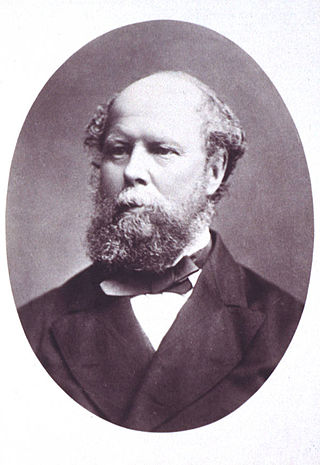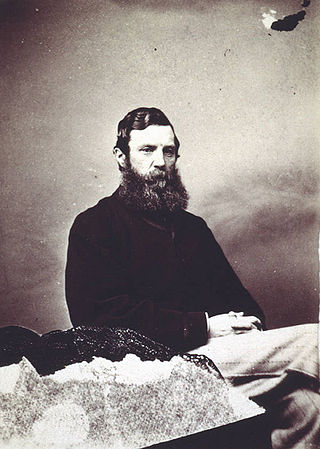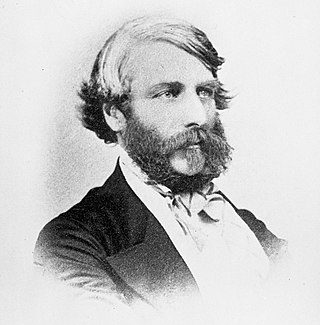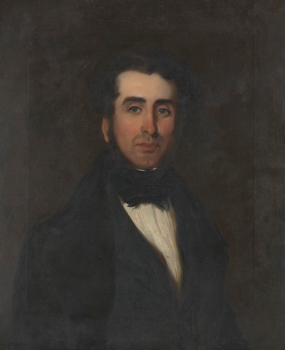
Longford is a town in the northern midlands of Tasmania, Australia. It lies 145 m above sea level at the convergence of the Macquarie River and the South Esk River, 21 km south of Launceston and a 15-minute drive from the airport. It is just south of the Illawarra Road, a road connecting the Bass and Midland Highways. It has a population of 3,863 and is part of the Northern Midlands Council area. The region is predominantly agricultural, noted for wool, dairy produce and stock breeding.
Cressy is a small town 35 kilometres (22 mi) south-west of Launceston, Tasmania. It came into existence in the 1850s to service the surrounding wheat farms. At the 2006 census, Cressy had a population of 670. It is known as Tasmania's "Trout capital" for the good fishing in the area. It is also home to an extensive agriculture research facility for the Tasmanian Institute of Agricultural Research.

William Lodewyk Crowther FRCS was a Tasmanian politician, who was Premier of Tasmania from 20 December 1878 to 29 October 1879.

Sir Richard Dry, KCMG was an Australian politician, the son of United Irish convict, who was Premier of Tasmania from 24 November 1866 until 1 August 1869 when he died in office. Dry was the first Tasmanian-born premier, and the first Tasmanian to be knighted.

Ronald Campbell Gunn, FRS, was a South African-born Australian botanist and politician.

William Thomas Napier Champ was a soldier and politician who served as the first Premier of Tasmania from 1856 to 1857. He was born in the United Kingdom.

Thomas George Gregson was the second Premier of Tasmania, serving from 26 February 1857 until 25 April 1857.

William Pritchard Weston was the third Premier of Tasmania.
A political family of Australia is a family in which multiple members are involved in Australian politics, particularly electoral politics. Members may be related by blood or marriage; often several generations or multiple siblings may be involved.

Brickendon Estate is a farm estate located in Longford, Tasmania. It is one of the two main ancestral homes of the Archer family, prominent local pioneers and politicians.

Woolmers Estate is a farming estate located in Longford, Tasmania, founded in 1817 by prominent grazier and member of parliament Thomas Archer. It consists of an 82ha property, including a two-part manor house, coach house, the National Rose Garden, extensive outbuildings and convict cottages and formal gardens. The main house consists of a brick nog weatherboard homestead, built in 1819, with an attached extensive addition in Italiate style, designed by William Archer and built in 1842-1843. From the 1819 completion of the main house to 1994, it was one of the main ancestral homes of the Archer family.
Alfred Youl was an Australian politician. He was a member of the Tasmanian House of Assembly for Longford from 1903 to 1909 and a member of the Tasmanian Legislative Council for Macquarie from 1909 to 1920.
William Dodery was an Australian politician.
William Archer (1820–1874) was an Australian architect, naturalist, grazier, politician and member of the prominent Archer family. He was the second son of Thomas Archer, a prominent pastoralist and politician himself. A keen interest in architecture led to him going to London to study architecture when he finished school, where he studied under William Rogers and Robert Stephenson. During his life he built many colonial buildings across Tasmania, served as a member of both the Tasmanian House of Assembly and Tasmanian Legislative Council and made significant contributions to botany, with several native Tasmanian plants named after him. Despite this he died penniless at his brothers house Fairfield on 15 October 1874.
Henry Butler, was a surgeon and politician in colonial Tasmania.

Robert Quayle Kermode was a British politician. He was a member of the Tasmanian Legislative Council and the Tasmanian House of Assembly in the 1850s and 1860s. In 1852 Godfrey Mundy claimed Kermode to be the richest Manxman in the world, in his book Our Antipodes. Kermode's mansion, Mona Vale, itself was at the time the largest house in Australia.

Horton College was a 19th-century independent Wesleyan methodist boys' boarding school, at Mona Vale near Ross, Tasmania, Australia. Founded by Captain Samuel Horton in 1855, the College closed in 1894; and during its brief period it was considered an extremely prestigious school, counting many of the region's landed families of the period as students.
Roderic O'Connor (1784–1860) was an Irish Australian landowner and public official, most notable for his activities as a land commissioner in Tasmania. He became one of the biggest landowners in Tasmania, and oversaw the modernisation of the land, typically using the forced labour of convicts.
The Tasmanian Heritage Register is the statutory heritage register of the Australian state of Tasmania. It is defined as a list of areas currently identified as having historic cultural heritage importance to Tasmania as a whole. The Register is kept by the Tasmanian Heritage Council within the meaning of the Tasmanian Historic Cultural Heritage Act 1995. It encompasses in addition the Heritage Register of the Tasmanian branch of the National Trust of Australia, which was merged into the Tasmanian Heritage Register. The enforcement of the heritage's requirements is managed by Heritage Tasmania.













